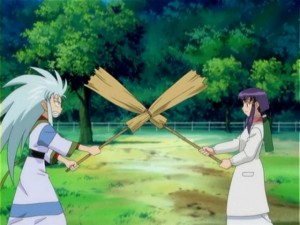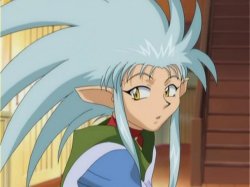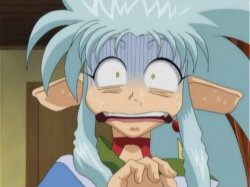Section 1.3: General Anime FAQ

What is SD?
SD means Super Deformed. Basically, this is when a character or characters are shown with over-exaggerated expressions, or are shown in chibbi (miniture) style. This is often done for humorous effect.
Here’s an example:


OAV stands for Original Animation Video. It is often also referred to as an OVA — Original Video Animation. These are direct to video titles which generally only run for a few episodes. Sometimes they help launch a TV series and the rest of the time, they are self-contained and designed to tell a compete story. However, if sales of an OVA are not good, a series may end up being incomplete. Budgets for OVA titles are usually higher than for a TV series, thus art and animation in OAV’s tends to be superior to TV series.
What is “doujinshi?”
Simply put, doujinshi is the Japanese word for “fan comic” or “fanzine.” Unlike America, in Japan, it is legal for fans to create their own works based on copyrighted materials and self-publish them in limited numbers for profit (say a few hundred copies to a couple of thousand copies). Since manga (or “comics”) are so huge in Japan, it is no wonder that so many people want to share their talents with other Japanese fans.
In the case of Kajishima-sensei’s doujinshi, it might seem odd that he would do such titles when as creator of Tenchi, he could get a manga publishing house to produce his works. While I do not know the exact reason for Kajishima-sensei going the doujinshi route, he is able to bypass bureaucratic and troubles that a manga publishing company would present. Thus Kajishima-sensei can give the hardcore TM!R fans copies of his artwork and provide them with additional information about TM!R that did not make it into the anime such as unused storyboards. Also, he can tell little tales that tease TM!R fans, like the “Tenko” doujinshi.
Sadly, as time has gone on, good archive sites of Tenchi doujinshi covers and the like have gone. Mary’s site still exists.
Here is an incomplete (and those who have other titles, please provide them if they are missing) list of Kajishima-sensei’s doujinshi, as provided by Watotsu.
- Muyou no Hitobito
- Fuyou no Hitobito
- Tenchi Yohou
- Tenchi Sokuhou
- Tenchi Zokuhou
- Tenchi Gohou
- Tenchi Ranpou
- Tenchi Shuuhou
- Tenchi Souran
- Souran no Tebiki
- Koukairoku
- Choukenroku
- Shuppanroku
- Omatsuri Zenjitsu no Yoru Heisei-ban 1
- Omatsuri Zenjitsu no Yoru Heisei-ban 2
- Omatsuri Zenjitsu no Yoru Heisei-ban 3
- Omatsuri Zenjitsu no Yoru Heisei-ban 4
- Omatsuri Zenjitsu no Yoru Heisei-ban 5
- Omatsuri Zenjitsu no Yoru Sayonara 20 Seiki
- Omatsuri Zenjitsu no Yoru Heisei-ban 5-kai
- Omatsuri Zenjitsu no Yoru 21 Seiki-ban 1
- Omatsuri Zenjitsu no Yoru GXP-ban
- Omatsuri Zenjitsu no Yoru GXP-ban 1
- Omatsuri Zenjitsu no Yoru GXP-ban 2
- Omatsuri Zenjitsu no Yoru Agga Ruter-ban
- Omatsuri Zenjitsu no Yoru GXP-ban #17
- Ianryokou Toujitsu no Yoru
- Ianryokou Toujitsu no Yoru 2
- Ianryokou Toujitsu no Yoru 3
It should be noted that these are Kajishima-sensei’s doujinshi, thus some titles will be about his other anime series and not just Tenchi.
Tenchi.org has four pages complete with scans of the front an back covers linked (based on Hiragana letters). There are also other doujinshi on these pages as well.
What are Japanese honorifics (titles)?
Japanese honorifics, like English ones, are used to confer honor on a person or to establish a social order. Unlike English honorifics (Mr., Mrs., Miss), Japanese honorifics are mostly gender-neutral and attached to a persons family name OR given name. Further, the Japanese have a wider range of honorifics for any number of situations. In Japan, the lack of use of an honorific is seen as extremely rude (think Ryoko, who refuses to use honorics) or intimate (husband and wife). TM!R is a series in which honorific usage is really very important.
-sama — This honorific denotes the greatest level of respect or submission on the part of the user. Seto is referred to as “Seto-sama” by most people because she is very powerful. Washu is generally known as “Washu-sama” because she’s the greatest scientist ever known, even though she doesn’t like being addressed that way. Aeka refers to Tenchi as “Tenchi-sama” because of him being Yosho’s descendent. However, as she is a woman of high upbringing who is in love with Tenchi, it is another reason that she addresses Tenchi with the -sama honorific, to show her reverence, submission, and respect for Tenchi.
-dono — This is a rarely used honorific in modern-day Japan. It has its roots in the warring states days of Japan and apparently used to be the highest honorific bestowed on a person (usually the samurai in charge of a village or town). This honorific has two uses today in Japanese literary works (to include anime and manga as well as novels).
- submissive — The use of -dono in the submissive form sometimes sees the term translated to “Master.” Yukinojo, Mihoshi’s nutty computer system, refers to Mihoshi as “Mihoshi-dono.” That’s because Mihoshi is his owner, thus making it proper for him to address her as such.
- non-submissive — This form of -dono is used when a person of great importance addresses someone else of great importance (in one way or another) and is sometimes translated as “Lord” or “Mister” or “Sir.” It allows the addresser to show great respect to the addressee without elevating them above the addresser. Washu and Seto-sama are the chief users of this form of -dono. Thus when Washu addresses Tenchi as “Tenchi-dono,” she recognizes him as an important and powerful person, and thus an equal of sorts.
-san — This is the general purpose honorific in Japan. It is commonly equated to the English Mr./Mrs./Miss honorifics and is used for any situation where politeness is required (which are many situations). This is reflected in TM!R with Tenchi addressing Mihoshi, Aeka, Noike, and other’s he meets with the -san honorific.
-chan — This is one of the more intimate honorifics in Japanese society as it has a more feminine take. It is primarily used for young children, girls, and pets. Girls will often address each other with the -chan honorific. It can be used to address males, but that is generally not appreciated. Despite what you saw in Pioneer’s translation of the series, -chan does not mean “little.” Washu made a big deal of getting people to address her (very improperly so) as “Washu-chan” because she’s trying to be cute and play up the “young girl” aspect of her appearance. Sasami is referred to by nearly everyone as “Sasami-chan” due to her age. Ryo-ohki is often refered to as “Ryo-chan” because of her pet and young-girl appearances. Rea refers to Tenchi as “Tenchi-chan” because she helped take care of him when he was little.
-kun — This honorific is less formal than -san and has a more masculine take. Of all honorifics, this one is the one most likely to be ignored by translators because they can’t come up with an appropriate translation for it. There are two uses for this honorific.
- informal — This form of -kun is used primarily to address boys or young men. Thus you see girls in school almost always refer to their male counter-parts with the -kun honorific. Males also can address each other with the -kun honorific, but it depends on the situation and relationship of the speakers.
- more formal — This form of -kun is primarily used in the work environment when a boss addresses his or her underlings, or by a teacher when addressing students. As such, the honorific is used to address both males AND females.
You may have noticed in episode 12 (if you watch using the Japanese audio track) that Dr. Clay refers to Washu as “Washu-kun,” indicating that he considers himself to be superior to her.
-senpai — Also spelled as “sempai” based on how it sounds to our English-speaking ears, this honorific is used by one to address those of more senior rank than themselves. It is mainly used in the school environment (through college), but can also be used in the work environment. Seina addresses Tenchi as “Tenchi-senpai” since Tenchi is older than him. The term can also be used as a stand-alone title, so Seina could just address Tenchi as “Senpai” and that would be fine too. The reverse of this is “-kouhai” which is used by the senior ranking person to address the lesser ranking person. However, this honorific is not required and often the senpai will simply address the lesser by name with an honorific, depending on how they view the person they are addressing.
-sensei — This honorific is a title to denote someone as master in his or her field. It can be used as an honorific or as a stand-alone title. ALL teachers/educators are addressed with this honorific. Others who are addressed with the sensei title/honorific are lawyers, doctors (all), authors (including manga-ka), or other such masters. TM!R creator KAJISHIMA Masaki is given the sensei honorific because he’s an author and anime creator.
no honorific — The lack of the use of an honorific either indicates rudeness or disrespect on the part of the addresser, or it indicates that the addresser feels a sense of intimacy to the addressee. The degree of intimacy is reflected on whether the addresser uses the addressee’s family name or given name. Ryoko addresses no one with an honorific, portraying the rude gaijin (foreigner). Because Tenchi uses no honorific to address Ryoko, it gives them a greater air of intimacy, even if Tenchi favors no one girl over another (per 101 Secrets). This lack of honorific usage between the two characters is why many Tenchi fans in Japan latched onto the notion of a Tenchi-Ryoko pairing.
-nee — This is the short term for “older sister.” While this form of the honorific isn’t that common, it is generally used by those addressing an older girl who is not the addresser’s actual sister, but for whom they look up to as a sister. Here are other forms of the term:
- (o)neechan — This is the least formal form to address an older sister or sister-type. This can be used as an honorific or as a stand-alone term. The “o” prefix honorific adds more respect to the honorific. “Neechan” is also used sometimes to address a waitress. Kids will often address an older girl (through their 20’s) as “oneechan” even if that girl is a stranger. Sasami-chan addresses Ryoko as “Ryoko-neechan” or “Ryoko-oneechan” even through Ryoko isn’t her actual sister.
- (o)neesan — Same as above, only more formal. Generally, one sees this used for actual family members.
- (o)neesama — Same as above, but it is the most formal use for “older sister.” Sometimes this form is used by younger girls in lieu of “senpai” to address an older girl they admire or to address a mentor. Sasami-chan has addressed her older sister Aeka as “Oneesama.”
-nii — This is the short term for “older brother.” While this form of the honorific isn’t that common, it is generally used by those addressing an older boy who is not the addresser’s actual brother, but for whom they look up to as a brother. Here are other forms of the term:
- (o)niichan — This is the least formal form to address an older brother or brother-type. This can be used as an honorific or as a stand-alone term. The “o” prefix honorific adds more respect to the honorific. This term is used a lot by younger girls to address older males up through their 20’s. It is also a term favored by those otaku into lolicon or have a little sister complex. Sasami-chan refers to Tenchi as “Tenchi-niichan” or “Tenchi-oniichan.”
- (o)niisan — Same as above, only more formal. Generally, one sees this used for actual family members.
- (o)niisama — Same as above, but it is the most formal use for “older brother.” Aeka addressed Yosho as “Yosho-niisama” or “Oniisama.”
Note: There are other terms for older brother and sister which are not discussed here, such as “aniki” or “ane-san.”
other honorifics — There are a few other honorifics of interest to bring to your attention. There are actually many more than I list here.
- (o)jou(chan/san/sama) — This is a title/honorific used to address a girl or young woman of someone important and rich, but who’s NOT a member of the royalty. “Ojouchan” can be used to address a young girl, but is often seen used in a rude way by thugs to a young woman they’ve eyed. “Ojousama” is used by the household staff of the rich young woman’s family to address her.
- waka — This the the masculine equivalent of “ojousama,” and is usually translated as “young master” or just “master.” I’ve never seen it used as an honorific, only as a title.
- bochan/bochama — This can be used as a stand-alone title or an honorific, and generally is translated as “young master.”
- -hime — This is a title/honorific for princess. Kagato refered to both Aeka and Sasami-chan with this honorific. To add more respect to the title, the sama honorific is attached to it (“himesama”).
- -han — This is an honorific of the same level as -san, but seems to only be used by those speaking with a Kyoto dialect.
- -tan — A cutesy form of the -chan honorific. I had thought it to be a cutesy form of -san but have been informed this is not correct.
- -chii — A cutesy, highly informal pseudo honorific. Ironically, this will often show up in translations, but not denoted as an honorific by using the dash. Instead, it will often be appended to the end of someone’s name, often as “tchi” (ie: “Yue-chii” becomes “Yuetchi”).
- -chama — A cutesy, childish form of the -sama honorific.
- –chin — Another cutesy, childish form of the -chan honorific.
- -tama — Another cutesy, childish form of the -sama honorific.
- -rin — Not really an honorific, but rather a cutesy modification to the end of name. This is often seen as similar to giving someone a nickname. So “Ryoko” might become “Ryorin.” “Sasami” might become “Sasamirin.”
What is a manga-ka?
A manga-ka is the author of a manga.
What is mahou shoujo?
Mahou shoujo literally means “magic girl” and as such is a girl who has magical powers. As an anime genre, mahou shoujo titles usually feature a young girl who gains magical powers due to some encounter with a magical creature (which may or may not have a humanoid form). The creature picks them to be the savior of the world to do certain things, as seen in the Pretty Sammy titles. There’s usually some sort of magic world that the creature comes from. Also, most mahou shoujo titles have a transformation sequence called henshin. These sequences has the girl lose her normal clothes and become clothed in her mahou shoujo costume. Mahou shoujo titles targeted at the otaku crowd will make these henshin moments contain graphic nudity while ones geared more toward the shoujo crowd won’t. Cardcaptor Sakura didn’t have a clothing henshin sequence, but instead had henshin sequences for capturing cards or activating cards.
